The rationale for some guidelines to suggest that not every reusable semi-critical device may necessarily require high-level disinfection or sterilization to prevent healthcare-associated infections was investigated.
July 6, 2021 (by: Lawrence F Muscarella, PhD) – Not every reusable semi-critical device may necessarily require high-level disinfection or sterilization to prevent healthcare-associated infections, some guidelines suggest.
Instead, these guidelines state that some semi-critical items, under certain circumstances and after cleaning, may undergo the less robust process of intermediate-level disinfection without apparently posing an increased infection risk.

The rationale for this somewhat unconventional recommendation was investigated because such advice may not be obvious or necessarily appear in line with other published guidance.
A cornerstone of infection prevention and patient safety, the proper decontamination of semi-critical devices, like all types of reusable medical equipment, requires a basic understanding of:
- the principles of, and differences between, disinfection and sterilization;
- the Spaulding device classification scheme; and
- the risk of infection associated with the device’s use.
 Consulting Services, Expert Guidance and Case Reviews: LFM-Healthcare Solutions, LLC provides medical expertise for hospitals, manufacturers and the public, specializing in healthcare-associated infections linked to contaminated reusable medical equipment. Value oriented with years of experience.
Consulting Services, Expert Guidance and Case Reviews: LFM-Healthcare Solutions, LLC provides medical expertise for hospitals, manufacturers and the public, specializing in healthcare-associated infections linked to contaminated reusable medical equipment. Value oriented with years of experience.
Spaulding’s Classification scheme
Published almost 50 years ago, the Spaulding Classification scheme — which since has been adopted by many countries and public health organizations, including FDA and the Centers for Disease Control and Prevention — classifies medical devices into one of three categories based on the item’s intended use and associated infection risk.
Disinfection is similarly divided into three categories, or “levels,” each distinguished from one another, and from sterilization, based on germicidal effectiveness. For each of Spaulding’s three device categories, decontamination guidelines recommend an appropriate level of disinfection or sterilization to prevent infections. Spaulding’s scheme can be refined, as warranted.
Posing a low infection risk, items that do not ordinarily contact the patient, or that are limited by their instructions for use to touching only intact skin, are classified as non-critical. Examples include such familiar devices as stethoscopes, crutches and blood pressure cuffs.
This category also includes environmental surfaces in healthcare settings, such as patient furniture, bedside tables and bedrails.
Guidelines recommend that non-critical items and surfaces be cleaned followed by low-level or intermediate-level disinfection, depending on the nature and extent of the contamination.
As its name indicates, low-level disinfection is the least robust of disinfection’s three levels, followed in increasing germicidal effectiveness by intermediate-level disinfection, high-level disinfection and sterilization.
- Related article — Dr. Muscarella’s “What You Need to Know When Replacing Disinfection with Sterilization of Flexible Endoscopes“
Posing an inherently higher infection risk, the Spaulding scheme classifies devices that contact intact mucous or nonintact skin during routine use as semi-critical. Examples include respiratory therapy and anesthesia equipment, and esophageal manometry probes.
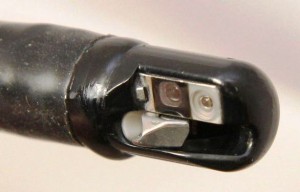
FDA and CDC also place gastrointestinal endoscopes and other types of flexible endoscopes in this category. In general, infection control guidelines recommend that semi-critical devices, particularly flexible endoscopes, undergo high-level disinfection, if not sterilization.
In recent years, significant federal attention has focused on the reprocessing of duodenoscopes, which are a type of flexible GI endoscope used to diagnose and treat disorders of the upper GI tract’s biliary and pancreatic ducts.
In January, an updated “multisociety” guideline was published focusing on some new issues impacting the reprocessing of flexible GI endoscopes. Federal guidance providing additional recommendations and instructions for reprocessing GI endoscopes and other types of reusable medical devices is readily available on-line.
Also this year, FDA issued alerts discussing the risk of infections associated with bronchoscopes and urological endoscopes, which are two other types of flexible (semi-critical) endoscopes used to diagnose and treat disorders of the respiratory tract and urinary tract, respectively.
According to the CDC, more healthcare–associated outbreaks have been linked to flexible endoscopes than to any other type of medical device.
Into the third category Spaulding’s scheme categorizes invasive devices that contact normally sterile tissues or enter the vasculature are classified as critical. Examples include surgical scalpels, biopsy forceps and orthopedic implants.
Sterilization is required of critical devices because they pose a high risk of infection if contaminated with microorganisms at the time of use.
 Scientific Affairs, Expert Guidance and Case Reviews: LFM-Healthcare Solutions, LLC provides medical expertise for hospitals, manufacturers and the public, specializing in healthcare-associated infections linked to contaminated reusable medical equipment. Value oriented with years of experience.
Scientific Affairs, Expert Guidance and Case Reviews: LFM-Healthcare Solutions, LLC provides medical expertise for hospitals, manufacturers and the public, specializing in healthcare-associated infections linked to contaminated reusable medical equipment. Value oriented with years of experience.
Superbugs, semi-critical devices and flexible endoscopes
Faulty reprocessing of flexible endoscopes and other types of semi-critical devices can pose a significant risk of transmitting many types of pathogens including multidrug-resistant organisms — or “superbugs.”
These nightmarish germs are microorganisms, predominantly bacteria, that are resistant to one or more classes of antimicrobial agents. In addition to third- or fourth-generation cephalosporins, these classes of antibiotics can include carbapenems, which are “last resort” antibiotics that may be used to treat serious bacterial infections.
Infections of carbapenem-resistant bacteria became a particular concern in the GI endoscopic setting beginning almost a decade ago, when reports first began to surface suggesting duodenoscopes might remain persistently contaminated and transmit superbugs despite reprocessing the device according to manufacturer’s instructions.

Since then, several outbreaks of superbugs and related multidrug-resistant organisms, including carbapenem-resistant Enterobacteriaceae, have been linked to duodenoscopes, bronchoscopes and urological instruments, among other types of flexible endoscopes, with associated patient morbidity and mortality.
The mortality rates of infections caused by some superbugs can be as high as 50% in the U.S. and globally, or higher. These superbugs include Candida auris, CRE and multidrug-resistant Pseudomonas aeruginosa.
A report in 2017 linked a duodenoscope to the possible transmission of a superbug carrying the mcr-1 gene, which can confer resistance to the antibiotic colistin. Like carbapenems, colistin may be used as a last-resort treatment for some multidrug-resistant infections. Some colistin-resistant infections may be untreatable.
Sterilization of semi-critical devices
Providing advice that may not necessarily be commonly known, some published guidelines have recommended that under certain circumstances and after cleaning, some semi-critical items may undergo intermediate-level disinfection (instead of high-level disinfection or sterilization).
As a point of emphasis and clarity, however, GI endoscopes are not one of these types of semi-critical devices, as FDA guidelines addressing the validation of reprocessing instructions for medical devices state.
More specifically, FDA stated, in a March 2015 guidance document, that semi-critical devices (following cleaning) should be sterilized when practical. Only if the design of the semi-critical device is incompatible with sterilization should high level disinfection then be used, the FDA wrote.

According to FDA, high-level disinfection does not “ensure the same margin of safety” as sterilization.
Five months later, in August of that year, FDA issued a safety alert recommending that duodenoscopes (which are semi-critical devices) undergo high-level disinfection at a minimum after manual cleaning.
Consistent with its March 2015 guidance, however, FDA clarified in this August 2015 alert that “[w]hen possible and practical, duodenoscopes should be sterilized due to the greater margin of safety provided by sterilization.”
Last month, FDA issued a safety communication that provided updated recommendations for reprocessing flexible bronchoscopes. Once again advancing sterilization, FDA advised in this June notice that when feasible and available, sterilization of bronchoscopes should be considered “because sterilization has a greater safety margin than high-level disinfection.“
Viruses, mycobacteria, bacterial spores
For background, the germicidal effectiveness of sterilization and disinfection’s three levels can be distinguished from one another based on their activity against certain “marker” organisms.
For example, low-level disinfection destroys most vegetative bacteria, lipid viruses and some fungi — but neither mycobacteria nor bacterial spores.
The least effective of the three, this level of disinfection can be achieved using a hospital disinfectant labeled to inactivate the hepatitis B virus and HIV. (The COVID-19 virus is an example of a lipid virus.)
While also effective against HBV and HIV, as well as all vegetative bacteria, some non-lipid viruses and fungi, intermediate-level disinfection additionally destroys mycobacteria.
Nevertheless, the more robust intermediate-level disinfection, compared to low-level disinfection, does not destroy bacterial spores, which are the most difficult microbial structures to eradicate using a physical or chemical process.
Examples of species of mycobacteria destroyed by intermediate-level disinfection (and by more potent processes) include Mycobacteria terrae, M. chimaera and M. tuberculosis, the latter strain of which causes pulmonary tuberculosis.
Intermediate-level disinfection can be achieved using a hospital disinfectant featuring a tuberculocidal claim.
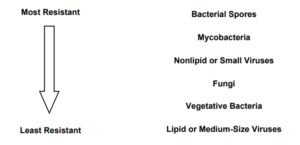
Unlike disinfection’s other two less effective levels, high-level disinfection is sporicidal. FDA defines this third level of disinfection as a lethal process that destroys “all forms of microbial life” — namely, mycobacteria, vegetative bacteria, fungi, viruses and bacterial spores, although not necessarily the resistant latter structures in “large numbers.“
Elaborating on this definition, FDA states that a high-level disinfectant is a sterilant used under the same contact conditions except during a shorter exposure time. While sporicidal, however, high-level disinfection may require as many as 32 hours of contact time (at room temperature) to pass a rigorous sporicidal activity test.
Sterilization, in contrast, destroys all forms of microbial life including large numbers of resistant bacterial spores, and generally during significantly shorter contact times than required for high-level disinfection (e.g., within a few minutes to a few hours, depending on the technology).
Species of bacterial spores that may be used to challenge and validate the effectiveness of a sterilization processes include Geobacillus stearothermophilus and Bacillus atrophaeus. Guidelines by the CDC provide additional information about sterilization and the relative resistance of disinfection’s three levels.
- Related article — Gastroenterology & Endoscopy News’s “Which Flexible Scopes Really Need Sterilization?“
The 2021 updated “multisociety” guideline
In January, an updated “multisociety” guideline was published focusing on the reprocessing of flexible GI endoscopes. This new guideline complements three earlier versions issued in 2003, 2011 and 2017.
As with each of these three prequels, this year’s updated guideline — entitled “Multisociety guideline on reprocessing flexible GI endoscopes and accessories” — was endorsed by several organizations specializing in gastroenterology, infection prevention, surgery, and epidemiology. In general, each version of this guideline is consistent with the another.
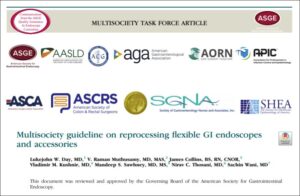
While reiterating several recommendations published in these earlier versions, however, this updated 2021 guideline discusses some newer topics including the use of single-use duodenoscopes and the practice of reprocessing of GI endoscopes during the COVID-19 pandemic. (The guideline advises that “there is no need for specific alterations in reprocessing protocols during the pandemic.”)
This 2021 multisociety guideline, however, in the section where it defines intermediate-level disinfection, provides the uncommon statement that “some” semi-critical devices “may undergo intermediate-level disinfection.” Although similar advice appears in a CDC guideline published in 2008, the rationale for such guidance is not obvious, particularly in the context of reprocessing GI endoscopes.
(This 2021 guideline’s advice about intermediate-level disinfection was not included in this multisociety guideline’s three earlier versions. Moreover, while certainly implied, this 2021 guideline does not explicitly identify GI endoscopes as semi-critical devices, unlike this guideline’s three earlier published versions.)
No matter, this newest version of this multisociety guideline — consistent with its three earlier versions, as well as infection control guidance published in Australia and Canada, among other countries — recommends high-level disinfection of GI endoscopes.
This 2021 multisociety guideline provides the additional advice that “use of ethylene oxide sterilization on duodenoscopes during infectious outbreaks has been associated with terminating these outbreaks and such a modality should be considered in selected settings and patient populations.“
Discussion: Possible explanations
There are a number of plausible reasons why an infection control guideline might advise, under certain circumstances, that some semi-critical devices can undergo intermediate-level disinfection, not high-level disinfection or sterilization as the FDA has advised.
For instance, similarly classifying most flexible endoscopes used in GI endoscopy as semi-critical, an overseas position statement, updated in 2018, states that semi-critical devices “require cleaning and disinfection with bactericidal, fungicidal, mycobactericidal, and virucidal activity.” Not included in this list is the recommendation that the disinfectant also be sporicidal, which raises two points.
First, FDA requires that virtually every biocide, method or process labeled for the high-level disinfection (or sterilization) of GI endoscopes be sporicidal. Examples include FDA-cleared high-level disinfectants whose active ingredient is ortho-phthalaldehyde, glutaraldehyde, peracetic acid and hydrogen peroxide.
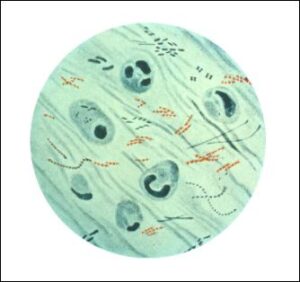
Second, CDC defines a disinfectant process that has bactericidal, fungicidal, mycobactericidal, and virucidal activity, but is not sporicidal, instead as achieving intermediate-level disinfection. Specifically, CDC defines intermediate-level disinfection as “a disinfection process that inactivates vegetative bacteria, most fungi, mycobacteria, and most viruses (particularly the enveloped viruses) but not bacterial spores.”
Along with low-level disinfection, intermediate-level disinfection is generally recommended for processing non-critical devices.
Whether this 2018 overseas position statement’s not requiring that the disinfectant process intended for semi-critical devices (e.g., GI endoscopes) also be sporicidal was inadvertent is unclear, although it could plausibly explain why a subsequently published guideline might state that some semi-critical devices may undergo intermediate-level disinfection (under certain conditions). (The 2021 multisociety guideline includes this 2018 overseas position statement in its bibliography.)
- Related article — Dr. Muscarella’s “Sterilization of Duodenoscopes Found to Terminate ‘Superbug Outbreaks.“
Hydrotherapy
At least two other possibilities may be considered to explain why a guideline might suggest, under certain circumstances, that some semi-critical devices can undergo intermediate-level disinfection, not at last high-level disinfection.
The first possibility involves federal guidance about the disinfection of hydrotherapy tanks and bed side rails as described in the CDC’s 2008 guideline for disinfection and sterilization in healthcare settings. That guideline’s Table 1 indicates that intermediate-level disinfection is appropriate for “some semicritical items1 and noncritical items.” The number “1” footnote embedded in this text refers to the guideline’s discussion of hydrotherapy.
Introducing the element of time, the CDC states, in this 2008 guideline, that “[s]ome items that may come in contact with nonintact skin for a brief period of time (i.e., hydrotherapy tanks, bed side rails) are usually considered noncritical surfaces and are disinfected with intermediate-level disinfectants (i.e., phenolic, iodophor, alcohol, chlorine).”
As previously discussed, FDA classifies devices that contact non-intact skin (or intact mucous membranes) as semi-critical requiring at least high-level disinfection.
Whether the CDC’s 2008 guideline discussing the disinfection of hydrotherapy tanks (contacting nonintact skin for a brief period of time) might provide a basis for, or contribute to, a subsequent guideline advising that some semi-critical devices can undergo intermediate-level disinfection is unclear, but also seems plausible.
Endoscope sheaths
Perhaps another possibility or consideration that might shed some light on this discussion is the publication of reports sanctioning the use of 70% alcohol, an intermediate-level disinfectant, to disinfect a certain type of flexible endoscope when covered with a sheath during use.
(Compared to high-level disinfection and sterilization, intermediate-level disinfection is a significantly less time-consuming process, as well as being less robust. For any disinfection or sterilization process, however, thoroughly cleaning the device first, using a detergent and brush, is necessary.)
 Almost a decade earlier in 2000, FDA issued a guidance document that classified ear-nose-and-throat (“ENT”) endoscopes as semi-critical devices for which the agency recommended high-level disinfection at a minimum. This document, which focuses on the clearance and use of sheaths with ENT endoscopes, stresses the importance of reprocessing the endoscope after removal of the sheath.
Almost a decade earlier in 2000, FDA issued a guidance document that classified ear-nose-and-throat (“ENT”) endoscopes as semi-critical devices for which the agency recommended high-level disinfection at a minimum. This document, which focuses on the clearance and use of sheaths with ENT endoscopes, stresses the importance of reprocessing the endoscope after removal of the sheath.
However, FDA advises in this 2000 guidance document that if the sheath’s “protective barrier properties” have been validated, “a cleaning procedure followed by an intermediate disinfection step will be required.”
Notwithstanding this FDA guidance, the CDC’s 2008 guideline published 8 years later recommends that healthcare facilities not “use a lower category of disinfection or cease to follow the appropriate disinfectant recommendations when using probe covers because these sheaths and condoms can fail.”
- Related article — Dr. Muscarella’s “The Reprocessing of Sheathed “ENT” Endoscopes, Cystoscopes and Other Types of Flexible Endoscopes.”
In what would be consistent with the CDC, the previous year Muscarella (2007) published guidance for reprocessing rigid laryngoscopes that recommended cleaning followed by at least high-level disinfection of the rigid laryngoscope’s reusable blade and handle “regardless of whether a protective barrier or sheath is used during the procedure.”
Providing an updated recommendation compared to its 2000 guidance document on the use of sheaths with ENT endoscopes, FDA advised 15 years later in March 2015, as Muscarella (2007) had previously published, that the cleaning instructions for a device that may be used with a protective cover or sheath “should assume the worst-case where the device is used uncovered, because of the potential for loss of cover integrity during use.”
- Related article — Dr. Muscarella’s “California Health Alert: Failure to Disinfect Reusable Semicritical Instrumentation Poses an Increased Risk of Infection.”
Summary and conclusions
A quality management program that assures proper oversight and execution of a sufficiently robust reprocessing program designed to prevent all types of reusable equipment from transmitting diseases is essential to public health and patient safety.
Although FDA recommended in March 2015 that semi-critical devices be thoroughly cleaned and then high-level disinfected when sterilization is not feasible, a few guidelines suggest that, under certain conditions, intermediate-level disinfection might be acceptable for some semi-critical devices.
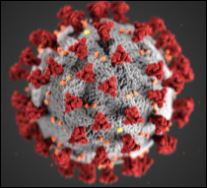
As a point of emphasis and clarity, GI endoscopes are not a type of semi-critical device that U.S. guidelines advise may undergo intermediate-level disinfection.
Indeed, FDA classifies GI endoscopes as semi-critical devices, recommending that the reprocessing instructions of semi-critical devices advise users “to thoroughly clean these devices and then reprocess them by sterilization. If the device design does not permit sterilization (e.g., device materials cannot withstand sterilization), then high level disinfection should be used.”
Circumspection seems prudent: only under clearly defined and explicitly documented circumstances, consistent with CDC guidelines, might it be acceptable for some semi-critical devices to undergo intermediate-level disinfection, not at least high-level disinfection.
Recommendations
The following recommendations and clarifications are provided to prevent contaminated flexible endoscopes — with a focus on GI endoscopes, particularly duodenoscopes, and bronchoscopes — from transmitting pathogens including multidrug-resistant organisms:
1. When feasible, sterilize the flexible endoscope after thoroughly cleaning all of its surfaces consistent with FDA’s guidance and with the manufacturer’s reprocessing instructions.
[a] Perform high-level disinfection if the design (and labeling) of the semi-critical device “does not permit sterilization” — for example, if the device’s delicate materials might be damaged by the sterilization process’s heat or chemical agent.
[b] Confirm that the high-level disinfectant used to reprocess the flexible endoscope is also sporicidal. Use the high-level disinfectant in strict accordance with its FDA-cleared instructions for use.
[c] Consistent with FDA recommendations at least for duodenoscopes, begin transitioning “to innovative duodenoscope designs that include disposable components such as disposable endcaps, or to fully disposable duodenoscopes when they become available.”
- FDA wrote last month about bronchoscopes in this same context of reprocessing and using single-use devices, “Consider using a single-use bronchoscope in situations where there is increased risk of spreading infection (for example, multidrug resistant microorganisms, immunocompromised patients, or patients with prion disease) or when there is no support for immediate reprocessing of the bronchoscope.”
2. Sterilize accessories, used with flexible endoscopes, labeled as critical devices, such as a reusable biopsy forceps, consistent wit manufacturer’s instructions.
3. Use caution and consider intermediate-level disinfection for some semi-critical devices (not GI endoscopes or bronchoscopes) only under clearly defined and explicitly documented circumstances, consistent with CDC guidelines.
[a] If performing intermediate-level disinfection of a cleaned semi-critical device, detail in the facility’s policies and procedures the type of device (e.g., hydrotherapy tanks) and the rationale for performing this practice in lieu of high-level disinfection or sterilization. Also reference the specific guideline or published advice in the policies and procedures that would be the basis for this practice.
[b] Prior to performing intermediate-level disinfection, confirm that this process is consistent with the device’s labeling and reprocessing instructions. Otherwise, follow the manufacturer instructions (e.g., perform high-level disinfection at a minimum).
4. Develop policies and procedures that detail whether, and under what specific conditions, the facility’s non-critical devices and/or environmental surfaces might undergo low-level or intermediate-level disinfection.
Note: This list of recommendations intended to reduce the risk of infection during GI endoscopy and other flexible endoscopic procedures is incomplete. Please review the manufacturer’s device labeling and instructions, as well as FDA and CDC guidelines, for additional guidance.
Article by: Lawrence F Muscarella, PhD. Copyright (2021). LFM Healthcare Solutions, LLC. All rights reserved. Dr. Muscarella is the president of LFM Healthcare Solutions, LLC, an independent quality improvement company. Click here for a discussion of his quality improvement healthcare services. E: Larry@LFM-HCS.com.